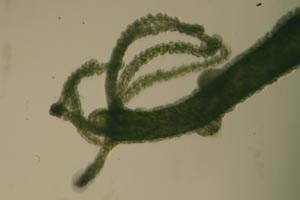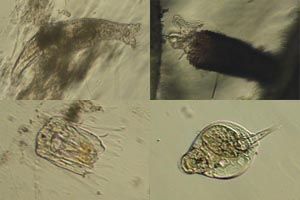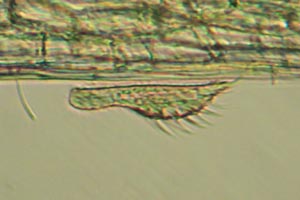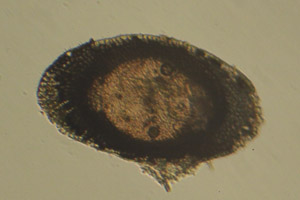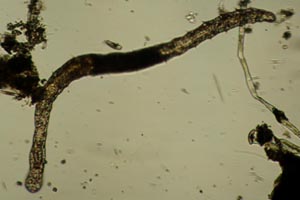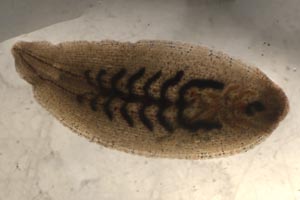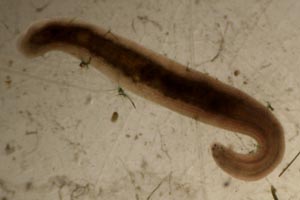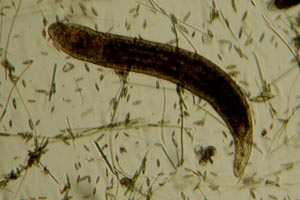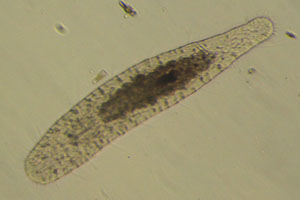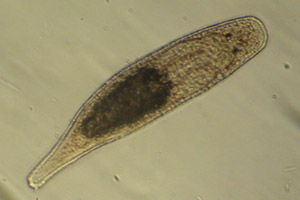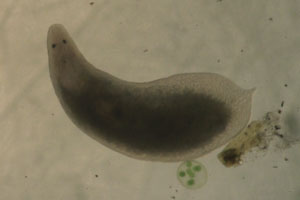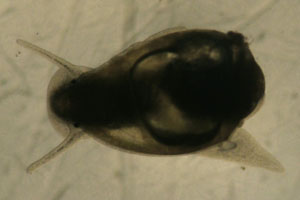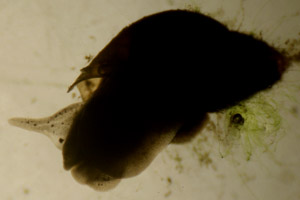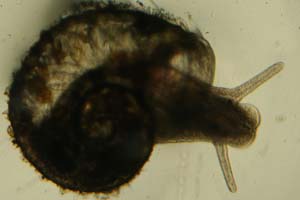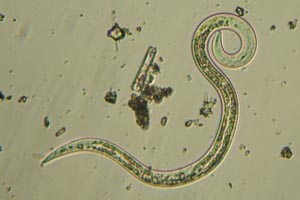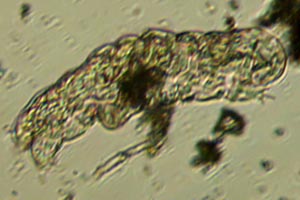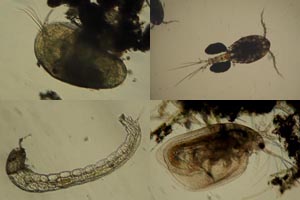Animals are nearly all multicellular with a central chamber or tube serving in acquiring and digesting food. Aside from sponges, they typically have distinct tissues including nerves and muscles that coordinate movement. Most thus act as a single functional unit, in some ways more like protozoans than complex plants, chromists, and fungi.
Adults vary from the size of ciliates to dozens of metres in length. Reproduction is commonly sexual, but the smallest kinds are often parthenogenetic, with females able to lay eggs without mating. Many other animals have a specialized larval stage, particularly those from oceans and lakes.
Phylum Cnidaria
Cnidaria have distinct tissues but no complex organ systems. Most have radial symmetry around the mouth, which is used for both ingestion and excretion, and is surrounded by stinging tentacles that capture prey. There are two main forms, attached polyps and free-swimming medusae.
Hydra
Greek hydra, water serpent
Angl. HYE-dra
Hydra are slender freshwater polyps up to 2 cm in length. They are contractile and can crawl by forming attachments at each end in alternation. They usually reproduce by budding.
Adults also have gonads, with both testes nearer and ovaries farther from the mouth. Most kinds are whitish or brown, but one species usually has green zoochlorellae.
Phylum Gnathifera – rotifers & allies
The remaining animals are usually bilaterally symmetric and have tissues arranged into distinct organs. Most have a digestive tract with two openings, and in some groups an internal body cavity or coelom. In smaller kinds, though, the latter is reduced or absent.
Rotifers are some of the most common animals less than 1 mm in size. The head has cilia around the mouth and pharyngeal jaws, and many have an adhesive foot.
Classes included here: Bdelloidea,
Monogononta
Phylum Gastrotricha
Gastrotrichs are aquatic and mostly less than 1 mm long. Most resemble rotifers and often have posterior adhesive glands, but no jaws or defined foot. Their bodies have cilia along the underside, scales on the back, and often sensory bristles around the head.
Chaetonotus
Greek chaitē, long hair, nōton, back
Angl. KEE-to-NOH-tus
Chaetonotus have a slender body with a forked posterior, making two toes. They differ from relatives in having spines formed from dorsal scales.
Phylum Bryozoa
Bryozoa are sedentary filter-feeders that grow into colonies. Each individual is polyp-shaped with many ciliated tentacles, which can be drawn into a protective case. Most freshwater kinds have tentacles in a horseshoe pattern, directly connected bodies, and produce dormant buds called statoblasts inside the colonies.
Statoblasts: Plumatellidae
Latin plumatus, feathered, -ella, dimn.
Angl. PLOO-ma-TEL-i-dee
Plumatellids have both larger attached and smaller floating statoblasts. The latter are oval, with a distinct outer ring of gas-filled chambers but not hooks or spines.
Phylum Annelida – segmented worms
Annelids include a variety of worms with bodies divided into repeating segments, each usually with bristles called setae. The mouth is behind an anterior projection or prostomium, which in some is part of a developed head. Many marine kinds have lateral appendages but others lack them and move by contractions.
Aphanoneura include a few small aquatic species. In these the prostomium is muscular and ciliated, used for both sucking up food and swimming, and aside from the setae the segments are indistinct. They usually reproduce by simple fission.
Aeolosoma
Greek aiolos, nimble, sōma, body
Angl. EE-o-lo-SOH-ma
Aeolosoma are 1-10 mm long with hair-like setae in ventral and dorsal bundles. They normally accumulate small coloured fat droplets spread throughout the body.
Naidids also have bundles of setae, some with notched ends, but only a reduced prostomium at most forming a small proboscis. Sexual reproduction involves a temporary band or clitellum that secretes a cocoon for the eggs, though again most smaller kinds reproduce by fission.
Chaetogaster
Greek chaitē, long hair, gastēr, belly
Angl. KEE-to-GAS-ter
Chaetogaster have short hook-like setae in ventral bundles, but none on the back. They are usually 1-20 mm long and often occur in chains before separating.
Hirudinida or leeches are larger and have anterior and posterior suckers, moving by taking steps with them. They have no setae and each segment appears as multiple rings. Different types are ectoparasites on large animals or predators of other small ones.
Glossiphoniidae
Greek glōssa, tongue, siphōn, tube
Angl. glo-SIF-o-NYE-i-dee
Glossiphoniids have a small anterior sucker and mouth, feeding through a proboscis. Most are flattened and have eyespots in 1-4 sequential pairs.
Erpobdellidae
Greek herpein, to crawl, bdella, leech
Angl. ER-pob-DEL-i-dee
Erpobdellids have wide mouths with no probosis or jaws, feeding by engulfing small prey. There are typically 3 or 4 pairs of eyespots set in two rows.
These are found mainly in North America and Europe; other continents also have related salifids with oral stylets.
Phylum Platyhelminthes – flatworms
Flatworms are largely aquatic carnivores or parasites, though some are terrestrial or more herbivorous. The digestive tract is sometimes branched but characteristically has a single main opening, or may be reduced or absent. Most mobile forms have cilia though they may also crawl or even swim using muscular contractions.
Stenostomum
Greek stenos, narrow, stoma, mouth
Angl. ste-NOS-to-mum
Stenostomum are slender with a pair of sensory pits at the front but no eyespots. There are also new pits near the middle, where they grow into head-to-tail chains that then separate.
Macrostomum
Greek makros, long, stoma, mouth
Angl. ma-KROS-to-mum
Macrostomum have the mouth as a front-to-back slit set close behind two eyespots. They are typically flat with rounded ends and usually a slightly bulged tail.
Dalyelliidae
After Sir John Dalyell, 1775-1851
Angl. DAL-ye-LYE-i-dee
Dalyelliids have an anterior mouth and barrel-shaped pharynx. The body is more or less cylindrical with a tapering tail. Most tend to be brownish or green and grow 1-5 mm.
Phaenocora
Greek phainein, to reveal, korē, pupil of eye
Angl. fee-NOK-or-a
Phaenocora have a forward-directed pharynx and flattened underside. The body tends to widen toward the posterior, which is pointed or round except for a minute tail.
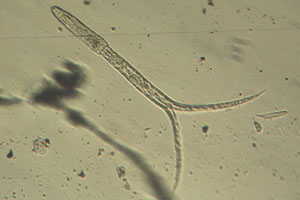
Fish Creek - body about 380 µm
Larvae: Trematoda ☣
Greek trēma, perforation
Trematodes are parasitic. Digenetic flukes after hatching first infect and multiply in molluscs. These release free-swimming larvae, often with a distinctive forked tail, called cercariae.
Cercariae then enter vertebrates, where they mature, or other intermediate hosts. A few tropical species infect humans; elsewhere some may enter skin but die leaving small rashes.
Phylum Mollusca
Molluscs have a mantle chamber around more or less of the body, including the reproductive, respiratory, and excretory organs. Most groups have a ventral foot, used to crawl or adhere to surfaces, and a distinct a head with a tongue-like radula used to rasp food. The smallest grow a few millimetres long.
Snails and other gastropods twist to one side during development. Most have a helical shell they can retract into, and often a lid or operculum that closes it behind them. However lids are lacking in pulmonate groups, which lack the usual gills and breathe air or water through a pore into a lung-like mantle cavity.
Physidae – tadpole snails
Greek physa, bellows or bubble
Angl. FIS-i-dee
Physids have thin tentacles with eyes at the base and their foot tapers to a point. In many types the mantle opening also has finger-like projections that act much like gills.
The shells here are sinistral, opening down to the left side as viewed from the end or spire. The breathing pore is likewise on the left.
Lymnaeidae – pond snails
Greek limnē, pond
Angl. lim-NEE-i-dee
Pond snails have flat, triangular tentacles with wide bases behind the eyes. They are also typically dextral, with the shell and breathing pore both opening to the right side.
Planorbidae – ramshorn snails
Latin planus, flat, orbis, orb
Angl. pla-NOR-bi-dee
Ramshorn snails have thin tentacles and a rounded foot. They breathe on the left but the shells are variable, usually flattened into a planar spiral or sometimes a low cone.
Phylum Nematoda – roundworms
Roundworms are typically long and slender. Along with the following phyla, they moult several times during growth, and have no cilia. Instead they move by whipping back and forth.
Free-living kinds are usually less than 2 mm long and are most common in soil, but there are also many aquatic and parasitic types.
Phylum Tardigrada
Tardigrades have four pairs of stubby appendages with claws or adhesive pads. Most kinds are less than 1 mm in size, and occur among submerged moss and debris.
Phylum Arthropoda – insects, crustaceans & allies
